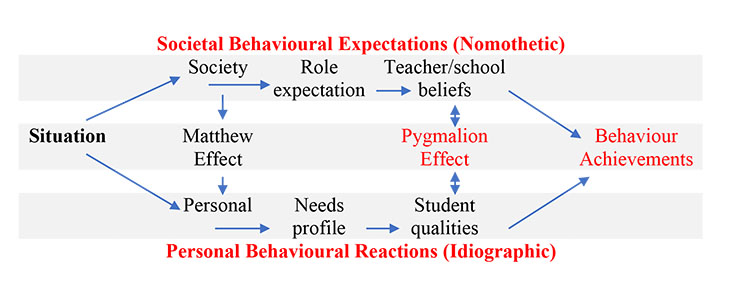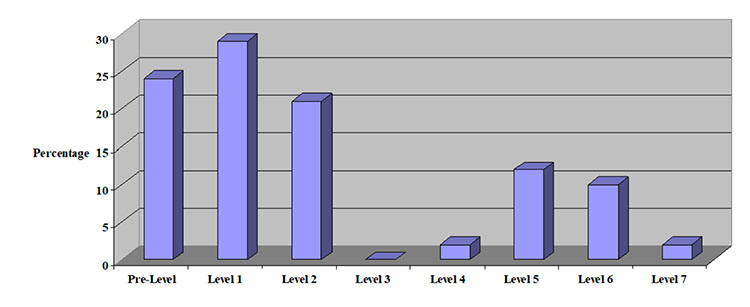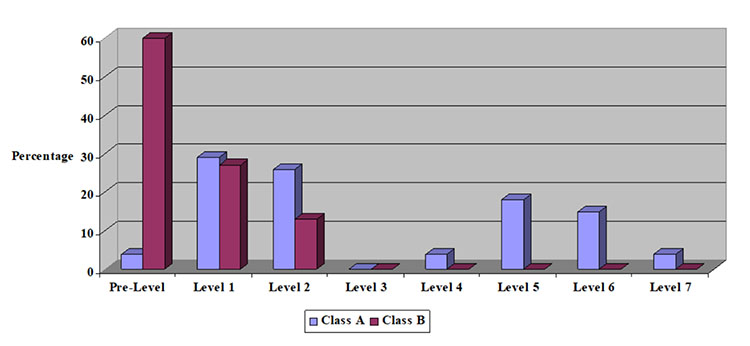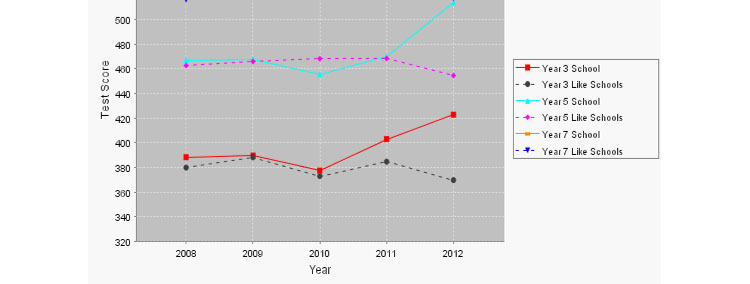How teachers' self-fulfilling prophecies, known as The Pygmalion Effect, influence students' success

Introduction
The factors that influence students’ educational success may be the result of either personal qualities or external influence, but some success may be a combination of both. The Getzels and Guba (1957) model examined social behaviour that included idiographic-nomothetic dimensions, which separated the individual personality/needs disposition (idiographic) from the institutional-role expectations (nomothetic). Reworking the model in Figure 1, we see a place for both The Matthew Effect and the Pygmalion Effect in the interplay between the idiographic and nomothetic dimensions of behaviour.
Figure 1. Pygmalion: The interplay between school/teacher beliefs and student achievement
 The Pygmalion Effect
The Pygmalion Effect
Pygmalion was a Greek sculptor living on Cyprus, who according to Ovid, carved a statue of a woman who was so beautiful he fell in love with it. The goddess, Venus, responded to Pygmalion’s prayers and the statue came to life. The story became an inspiration for George Bernard Shaw who wrote the play Pygmalion, and the musical, My Fair Lady, later developed Shaw’s idea.
It is interesting that Pygmalion’s wife was never named in the ancient literature, and Helen Law (1932) who examined the modern naming of Pygmalion’s wife, Galatea, concluded:
'I know of no exact parallel to this particular case, i.e. no other case in which in modern times a name not in the ancient writers has been added to a myth and the name has been so commonly accepted by popular usage that it has crept into mythological handbooks' (p. 342).
George Bernard Shaw’s play, Pygmalion, first appeared in 1913, and it tells the story of how Eliza Doolittle, a kerb-side flower seller, is transformed into an upper-class lady by learning the appropriate elocution. Shaw was a committed Fabian socialist and, at one level, he pokes fun at upper-class pretentions, but he also develops a modern variation of the Pygmalion myth in which an artist such as Henry Higgins can mould another being in his own image.
Pygmalion in the classroom. In the Preface of Rosenthal and Jacobson’s Pygmalion in the Classroom (1968), the authors made the point that the book is about self-fulfilling prophecies: “how one person’s expectation for another person’s behaviour can quite unwittingly become a more accurate simply for its having been made” (p. vii). This phenomenon is well known to teachers and they see it at work in their classrooms every day, and it is often repeated when students are asked to recall the teachers who made a real difference to their life prospects. While this book from the 1960s may upset the contemporary, politically-correct sensitivities, the message that survives relates to self-fulfilling prophecies and the importance of teacher-student professional relationships.
In Rosenthal and Jacobson’s research the teachers aggregated and progressed the original Halo Effects (Thorndike), thus boosting perceptions of students’ intelligence and academic performance. Furthermore, positive developmental perceptions of the selected students’ classroom behaviours (curious, interesting, future success, adjusted, appealing, happy, affectionate, less hostile, and needing approval [p. 109]) were all recorded. The Pygmalion Effect clearly advantaged the students’ self-perceptions in this study. It is important, however, to understand that the converse is true, and in such instances where this occurs, we see a downward spiral.
The power of feedback. Students thrive on positive feedback. Many of us were brought up in the presence of the much-repeated aphorism: “Nothing succeeds like success”, and parents used this wise saying as an incentive and a guide in the life planning for their children. However, this guide to action was in constant use by every thinking person, and then in 1977 Albert Bandura developed the theory of self-efficacy, in which individuals who understood their personal strengths then further developed their abilities to succeed. Mihaly Csikszentmihalyi (1997), in his work on the concept of Flow, described what he called an autotelic (self goal-setting) personality that appeared to be a development of self-efficacy. Csikszentmihalyi said, “Applied to personality, autotelic denotes an individual who generally does things for their own sake, rather than in order to achieve some later external goal” (p. 117).
Bandura’s ground-breaking work spawned a lot of exceptional research into the measurement of self-efficacy of students, teachers and principals. Tschannen-Moran and Woolfolk Hoy (2001, p. 783) observed that, “Teacher efficacy has proved to be powerfully related to many meaningful educational outcomes such as teachers’ persistence, enthusiasm, commitment and instructional behavior, as well as student outcomes such as achievement, motivation, and self-efficacy beliefs.” The link between teacher self-efficacy and pedagogic mastery was acknowledged by Tschannen-Moran and Woolfolk Hoy (2007, p. 954) who confirmed Bandura’s prediction that mastery experiences made the greatest contribution to teachers’ senses of self-efficacy. The link between mastery and self-efficacy holds for students, too.
John Hattie’s ground-breaking meta-analyses ranked teacher feedback as highly effective in improving students’ learning. Narissa Leung (2019) noted, “Hattie says that the aim of feedback is to reduce the gap from where students are and where they aim to be. So, unless we have a clear idea of where this lesson is going and what the expected outcomes are, we can't tell if students are making successful gains.” Hattie’s (2011) statement on feedback in schools noted that, “The average effect-size was 0.79, which is twice the average effect of all other schooling effects. This places feedback in the top 10 influences on achievement ….” While all feedback is important, we have noted that in schools, feedback has four dimensions (Table 1), all of which influence the Pygmalion Effect development. The least studied mode of feedback remains the informal feedback, which is often reduced to perceptions of body language and voice tones that are so difficult to perceive and measure.
Table 1
Types of Feedback Experienced by Students
|
FEEDBACK TYPES |
Feedback Positive |
Feedback Negative |
|
Feedback Formal |
Awards | Formal corrections |
|
Feedback Informal |
Friendly smiles | Unfriendly responses |
Operationalising the Pygmalion Effect in a Classroom
In attempting to bring about change in teachers’ pedagogic styles, school leaders, and indeed school leadership teams, have to work hard to re-culture their teaching and learning communities in such a way that teachers look beyond both the demographics of the school’s context (Matthew Effect) and the individual student where the Pygmalion Effect - in either a positive or negative sense - will manifest itself. As we stated in our paper on The Matthew Effect, “If we submit to the idea that belief drives behaviour then it is possible to create learning and teaching communities that stop this phenomenon in its tracks through the deliberate actions of their leaders” (Boyd & MacNeill, 2020).
As already noted, success breeds success. Notwithstanding, there is the notion that, particularly in young children, the opposite also holds true. It is here that the classroom teacher plays a fundamental role in two ways. Firstly, in the learning experiences that they provide for students, and secondly, in the way they provide feedback. ‘No Failure Learning’ is, therefore, where Pygmalion sits because “it advocates the scaffolding of learning into manageable parts” while modelling “safe, student-student and student-teacher dialogue” (Boyd, MacNeill & Sullivan, 2019). It is through the deliberate actions of the teacher within this learning environment that future success is more likely guaranteed. This was evident in 2009 where, as a principal, the lead author witnessed first-hand the difference a teacher’s belief in relation to student abilities played in achievement levels in the domain of literacy. At this time, the administration team had established a sight word target of 20 words for pre-primary students. The school had two classes that we had split evenly in terms of ability levels and gender. For two thirds of the year the classes’ achievements were tracking relatively evenly. Then something happened. The teacher in Class A had stated, “I think our kids are capable of so much more, and I think I have found a way in which I can scaffold their learning in order to support concept development and attainment”.
By the end of the year, the differences were such that it was impossible not to take notice of the curriculum delivery approaches being used. In relation to the sight word target of 20, Class A had eight students who did not reach this target. The highest number of words recognised was 154. Eight students in this class recorded scores in excess of 100, with the remaining eleven students recognising between 22 and 93 words. Sixteen students could spell the words they recognised. The highest number of words spelled was 145.
In Class B, 23 students did not reach the target. The highest number of words recognised was 32 with the remaining students sitting between 20 and 28 words. A total of four students achieved or bettered the target.
It is important to note that both teachers were, passionate about what they did, and they worked hard for their classes. The only difference was that the teacher in Class A felt that she was under-selling the capabilities of her students and, as a result, through an altered pedagogy and new expectations in terms of achievement, she supported her students to reach higher achievement levels.
As a direct result of this, the flow-on effect was remarkable. In 2010, the following results were achieved through altered instructional strategies. The graph below shows word recognition totals for our 4 and 5-year-old students in 2010. For our four year olds the target was 12 words. As is clearly illustrated, 3 of the 4-year-olds were recognising 200 words and 13 of our 5-year-olds were recognising 200 or better. It is worth pointing out that in multiple instances these children were also spelling these words. These results demonstrated the Pygmalion Effect taking hold in three classes after the initial data sets at the end of 2009.
Graph 1.
Word recognition levels of Kindy and Pre-primary students in 2010
Further to this, the Pygmalion Effect cascades when skills are scaffolded carefully. In the case of the data sets from the school, word recognition rates had an impact on reading data. If we go back to the data sets from 2009, we now examine the reading data. Once again, it is important to note that until teacher A changed her expectations and delivery style, both classes we were on very similar achievement tracks.
Graph 2.
Aggregated 2009 Reading Level Data for Class A and B
The data illustrated in Graph 2 does not look overly impressive or suggest that there is anything startling in the reading levels of the students in the 2009 pre-primary cohort. However, when we separate the data sets they tell a very different story and the Pygmalion Effect again reveals its impact.
Graph 3.
Disaggregated 2009 Pre-primary reading level data for Class A and B
In class B, (16 of 27) 60% of the students were still at pre-reading levels with the just over 10% of the students achieving at level 2. In Class A, 1 student, representing 3% of the class, was at pre-reading level. More importantly, and of significant difference to Class B, 1 student (3%) achieved at level 7. This was moving the students into early reading stages something, traditionally, we did not see in the school until late year 1. Building on this further, the ripple effect of one teacher’s belief in her students’ potential ability levels had a knock-on effect in later years, with subsequent classroom teachers of these students raising their expectations and altering their teaching accordingly. Not only did we see these pre-primary students’ achievement levels as Year 3 students in 2012 the highest we had ever recorded in the school, but the cohort’s achievements preceding this saw increased achievement levels too.
Graph 4.
Year 3 Average Spelling Achievement Against Like Schools in WA
Not only are we seeing in practice the reworking of the Getzels Guba model in Figure 1, in action, we also are seeing the aphorism: “Nothing succeeds like success” playing out across the school community as well.
Conclusions
In this paper we were keen to demonstrate that while the Matthew Effect includes schools, students and teachers in many ways, we can put our fingers on the scales of improving the lives of all players by utilising strategies that can be called The Pygmalion Effect. The challenge for all educators is to move beyond the Henry Higgins superficiality, as he worked with Eliza Doolittle, to making a life-long commitment to bridging the achievement gap in the students’ school years.
Through effective positive feedback and highly-structured scaffolded teaching and learning processes, teachers have the capacity to positively influence students’ self-efficacy to a level that enables them to overcome the environmental and societal factors that education has come to use as the predetermining measure of future success. This is the Pygmalion Effect in action.
References
Bandura, A. (1997). Self-Efficacy: Toward a unifying theory of behavioural change. Psychological Review, 84(2), 191-215.
Boyd, R., & MacNeill, N. (2020). The Matthew Effect: School Boundaries, School Funding and Resources, and School Staff. Education Today. Retrieved from https://www.educationtoday.com.au/news-detail/The-Matthew-Effect-4936
Boyd, R., MacNeill, N., & Sullivan G. (2019). No failure learning: Growing the skills and knowledge in every student. Education Today. Retrieved from https://www.educationtoday.com.au/issue/2019+Vol+19+%281%29+Term+1-139
Csikszentmihalyi, M. (1997). Finding Flow. New York: Basic Books.
Getzels, J.W., & Guba, E.G. (1957, Winter). Social behavior and the administrative process. The School Review, 65(4), 423-441.
Law, H. (1932). The name Galatea in the Pygmalion myth. The Classical Journal, 27(5), 337-342.
Leung, N. (2019). Developing and delivering effective feedback. Retrieved from https://www.education.vic.gov.au/school/teachers/classrooms/Pages/approacheshitsmasterclassnleung.aspx
Hattie, J. (2011). Feedback in schools. Retrieved from https://www.visiblelearning.com/sites/default/files/Feedback%20article.pdf
Merton, R.K. (1968, January 5). The Matthew Effect in Science. Science, 159(3810), 56-63.
Rosenthal, R., & Jacobson, L. (1968). Pygmalion in the classroom: Teacher expectation and pupils’ intellectual development. New York: Holt, Rinehart and Winston.
Tschannen-Moran, M., & Woolfolk Hoy, A. (2001). Teacher efficacy: Capturing an elusive construct. Teaching and Teacher Education, 17, 783-805.
Tschannen-Moran, M., & Woolfolk Hoy, A. (2007). The differential antecedents of self-efficacy beliefs of novice and experienced teachers. Teaching and Teacher Education, 23, 944-956.
Tschannen-Moran, M., & Woolfolk Hoy, A. (n.d.). Teacher Beliefs – TSES. Retrieved from https://wmpeople.wm.edu/asset/index/mxtsch/tsesomr
Photo by Gelgas Airlangga from Pexels